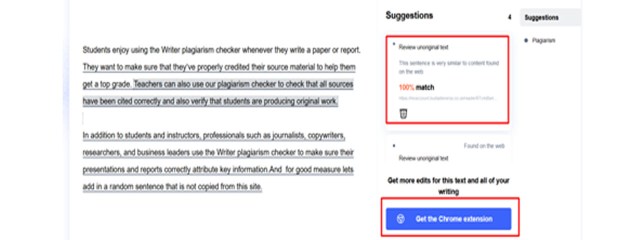Plagiarism is a common problem face by writers all over the world with the proliferation of the internet and the ease of access to knowledge worldwide.
However, as worrisome as it sounds, there are ways to combat plagiarism. This is possible due to the awareness against plagiarism and the ease with which one can use. An online tool to check if the content is plagiarize or not.
Let’s see in more detail what is plagiarism and what are some good tools that can be use to make sure your write-up is free from such an issue.
What is plagiarism?
According to the University of Oxford, plagiarism is “presenting someone else’s work or ideas as your own, with or without their consent, by incorporating it into your work without full acknowledgement”.
It is essentially theft of intellectual property and as such, it is illegal. If someone is found to be plagiarizing, their reputation will be severely affected. They might lose all their credibility.
Plagiarism has a few types that differentiate from each other a little bit, let’s look into what these types are.
1. Global Plagiarism
This is the most common and most offensive type of plagiarism. The perpetrator takes the complete work of another author and passes it off as if it were their own.
This type of plagiarism has the most serious consequences as the original author or owner of the work can take legal action against the perpetrator.
2. Patchwork Plagiarism
In this type of plagiarism, the perpetrator takes parts of the works of other authors and incorporates them into their work without giving any citations.
In some cases, the perpetrator even makes up an entirely new work by using the stolen parts. This is a cleverer kind of plagiarism that is a bit more difficult to detect duplicate content.
3. Self-Plagiarism
When an author submits a new paper or work that has parts copied from their previous works. After that is called self-plagiarism. This doesn’t have serious ramifications usually. If express permission is give then it is even legal to do so in some cases.
Usually, students end up doing this type of plagiarism by turning in the same work for different assignments.
4. Accidental plagiarism
Plagiarism occurs not due to evil intent but due to oversight. For example, if an author uses the work of another, correctly cites the name of the used work but accidentally credits the wrong author. If the perpetrator wrongly cites the work of others, misquotes them, or changes the words of the quoted content without changing the meaning, then this also counts as accidental plagiarism.
This is an unintentional type of plagiarism and relatively innocent compared to other types of plagiarism. However, it still has serious consequences. To avoid plagiarism, people can use online tools known as plagiarism checkers to ensure that their work is genuine and free of plagiarism.
Also Read: Affordable SEO Article Writing Service
What are Plagiarism Checkers? How Do They Work?
Specialized software exists to check plagiarism in your work. These tools are a reliable way to make sure your work does not contain plagiarism, especially the accidental kind.
There exist a lot of plagiarism checking tools online, some are clearly better than others. One can get overwhelmed by the number of choices available. And it can be a difficult task to find out which plagiarism checker is reliable or not.
To avoid that hassle, let’s look into 3 reliable plagiarism checkers.
1. Editpad.org

Editpad offers multiple services such as a paraphraser, a word processor and of course, a plagiarism checker.
This tool allows you to check your work and see if it has plagiarized content or not. It is a free tool that can be use anywhere as long as you have a reliable internet connection.
Some of its features are listed below:
Features:
- Upload documents for checking.
- Type or copy text for checking.
- Allows you to see the percentage of plagiarized and unique content.
- Check for plagiarism across 13 languages.
- Can download the results as a report.
This tool is good for removing any plagiarism that one may have accidentally done. It has several pros that make it a prime choice for anyone looking for a plagiarism checker.
Pros
- It is very fast when checking for plagiarism
- Reliable results
- URLs are listed for the sources which were plagiarized from
- Sentences are highlight in red for plagiarize and green for unique
- Free to use
- No word-limit
Cons
- Too many ads
- Captcha verification require
2. Writer.com

Writer has a robust plagiarism checker that stands out from the rest due to some unique features. Writer primarily offers a writing assisting tool that requires a subscription and has a free trial period.
They offer a free plagiarism checker aside from their writing assistant tool. The plagiarism checker is mostly reliable. Let us see what this tool has to offer in the way of features, pros and cons.
Features
- Real-time plagiarism checker. All you need to do is start writing text and results will start showing almost instantly.
- No button for starting the check; automatically detects whether some text has been written or not.
- Gives percentage of plagiarism for each plagiarized sentence.
- Underlines plagiarized content.
Pros
- It has a Chrome extension
- AI-based intelligent checking.
- URLs are listed for plagiarize text.
- Free to use.
Cons
- Sometimes a few lines that are plagiarized are not detect duplicate content.
3. Rephrase.info

Rephrase.info offers a plagiarism checker, among other content optimization tools. This is a robust tool and is free to use. This is web-base you can use it anytime you are online. AI-base tools are well known to have reliable results and provide more detail analysis. This tool does not fall short of such expectations.
Some of the great features that make it stand out are:
Features
- Support for English, Espanola and Indonesian.
- Compares text with different types of resources.
- Your privacy is not compromised.
- Deep scanning using artificial intelligence
Pros
- Free to use
- Red highlights plagiarized content, green highlights original material
- Percentages are shown for unique and plagiarized material
- URLs are given for material that was not cited.
Cons
- 1000-word limit per check
- Advertisements
- Captcha verification require
Also Read: How To Increase Website Traffic By 200% In One Month
Conclusion
These were 3 tools to check for plagiarism online. All of these tools are completely free to use. There are no bothersome pop-ups asking for your credit card info, and more importantly, these tools work well.
We saw that Editpad’s plagiarism checker was free to use, had no word limit when searching for duplication and offered support for 13 languages.
Moreover, it had color coding for duplicated content, and it showed the URLs of the original sources, making it easy to cite them.
Writer.com’s checker worked in real-time without requiring a button press and showed results as soon as you started typing. It also provided a useful feature that allowed you to integrate its plagiarism checker into your Chrome browser.
Rephrase.info’s checker AI-based and used deep scanning for a thorough result. It came with the added benefits of safeguarding user privacy.
It also supported 3 languages I.e., English, Indonesian and Espanol. Using these tools, you can make sure that your work is free of plagiarism and authentic.




